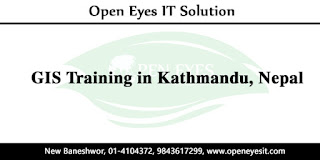 |
| GIS Training in Kathmandu Nepal |
This course is an elective course for explores some of the ways in which remote sensing systems provide geospatial information that is relevant, accurate, timely, accessible, available in an appropriate format, and cost-effective. Recent developments in Earth observation such as imaging radar, LiDAR and hyperspectral sensors are increasing the wealth of information that can be generated from remotely sensed data sources. As a consequence numerous new GIS applications, that rely on advanced remotely sensed data sources, have emerged at local, regional and global scales. We will cover several topics:
 |
| GIS Training in Kathmandu Nepal |
Remote Sensing Principles – We start by examining the history and modern-day scope of remote sensing and continue with an in-depth review of the full electromagnetic spectrum since the interpretation of remote sensing imagery depends first and foremost, on a sound understanding of electromagnetic radiation and its interaction with the surfaces and atmosphere.
 |
| GIS Training in Kathmandu Nepal |
Image Acquisition – Here we examine the fundamentals involved in image acquisition, by examining a variety of topics associated with digital photographic sensor systems, the role an importance of digital data, the typical steps that would be involved in transforming these digital data into information (i.e. image interpretation), the various Earth observation missions launched thus far, various contributions provided by microwave, LiDAR, thermal sensor systems, and the role of image resolution in projects integrating remote sensing and GIS.
 |
| GIS Training in Kathmandu Nepal |
Image Analysis – We next take up the typical remote sensing for GIS workflow that starts with one or more forms of preprocessing (i.e. radiometric, geometric corrections, and feature extraction), continues with the process of assigning pixels to classes using one or more forms of digital image classification, and typically concludes with the collection and use of field data for model calibration and accuracy assessment. We will also examine hyperspectral remote sensing, which utilizes many of the aforementioned principles and methods, but requires specialized data sets, instruments, field data and software.
 |
| GIS Training in Kathmandu Nepal |
GIS / Remote Sensing Applications – We will conclude the course by looking at the various ways in
which GIS and remote sensing have been integrated and used to characterize vegetation (i.e.land use/land cover), geologic, geomorphic, soil and hydrologic phenomena at a variety of scales ranging from individual land parcels and neighborhoods to first cities, regions, continents, hemispheres and nowadays, to the entire globe.
 |
| GIS Training in Kathmandu Nepal |
Learning Outcomes
When you have completed this course, you will be able to:
- Explain the principles of remote sensing and the technical characteristics and constraints of Earth Observation missions
- Design, implement and critically evaluate methods of digital image processing ranging from preprocessing to image classification, field data collection and accuracy assessment
- Generate geographical information by processing digital remotely sensed data and critically evaluate its use for environmental applications
- Critically evaluate the opportunities and available methods for integrating remote sensing and GIS.
 |
| GIS Training in Kathmandu Nepal |
Course Formats
As students you are expected to engage with the information you are learning and to explore the heady cauldron of ideas, opinion, and analysis that describe our collective effort to thoroughly interrogate the subject at hand. Learning arises from active engagement with the knowledge found in our reading materials and with one another. As in any level class, the instructor’s role is that of a guide who keeps you on this path of discovery and you will find that you will learn much from your fellow classmates. The challenge for us is to replicate such an academic experience within the milieu of “online learning”.
 |
| GIS Training in Kathmandu Nepal |
All course materials will be organized through Blackboard. The main theoretical concepts will be provided through course notes and assigned readings and the assignments will give students an opportunity to internalize and apply the concepts and theory learned from readings. Some assignments require students interaction, all will benefit from it.We have several technologies that will facilitate our course work and our interactions, despite our dispersed locations. These include:
 |
| GIS Training in Kathmandu Nepal |
Blackboard – All course materials and correspondence will be posted on the course Blackboard site. As a registered student you’ll find this course will show up in your available courses at noon Pacific Time on the first day of classes. It is here that the day-to-day flow of the course will be recorded.
 |
| GIS Training in Kathmandu Nepal |
Discussion boards and Blogs – On the Blackboard site, we’ll post a number of discussion threads relevant to various sections of the course. I may or may not participate in these threads but they are vitally important when we get to some of the "hands-on" work as we expect students to work "together" on these exercises, sharing hints and help as you would do in a common laboratory classroom. Additional discussion threads may be used to organize asynchronous discussions.
Live meetings and presentations - At USC, we use a browser-based service called Adobe Connect to
create synchronous interaction sessions. With voice and webcam capabilities Adobe Connect can be used to share presentations and even our desktops between two or more people.
 |
| GIS Training in Kathmandu Nepal |
Individual meetings - While Adobe Connect can be used for one-on-one meetings, we generally
find it’s easier to use the free VOIP and chat technology, Skype (http://www.skype.com) for
individual chats.
No comments:
Post a Comment